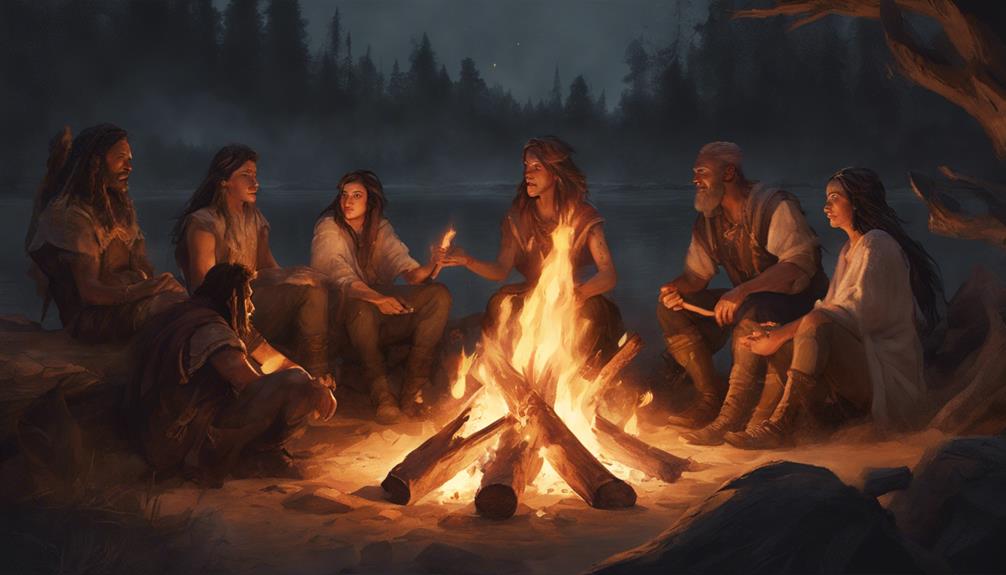The intricate relationship between stories and legends with culture unveils a profound interconnectedness that goes beyond mere entertainment. These narratives serve as the threads that weave the fabric of societies, shaping beliefs, values, and norms in ways that are both subtle and profound. By examining the intricate layers of storytelling, one can uncover the hidden mechanisms through which tales influence the very essence of human existence. The impact of these narratives on culture is a complex tapestry waiting to be unraveled, revealing the layers of significance that underlie our collective heritage.
Key Takeaways
- Stories transmit cultural values and knowledge through generations.
- Folktales instill moral lessons and ethical guidance.
- Cultural narratives influence societal behavior and norms.
- Legends and myths symbolize virtues, vices, and societal ideals.
Origins of Cultural Stories
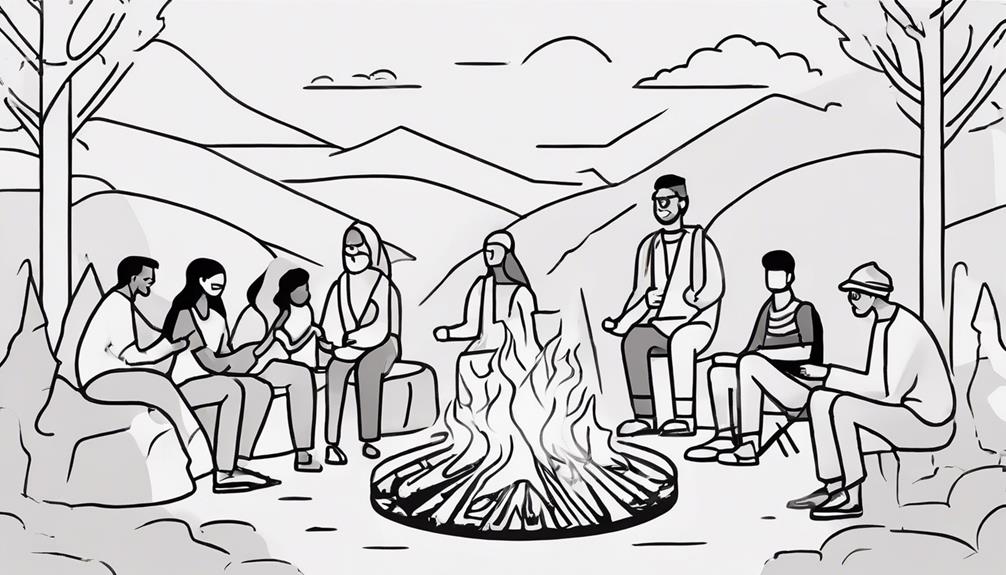
Exploring the historical roots of cultural stories reveals a rich tapestry of ancient myths, legends, and folklore that have endured through generations, embodying the fundamental beliefs, values, and traditions of diverse societies. Ancient cultural stories often served as a way for communities to explain the unexplainable, such as natural phenomena, the origins of the world, or the behavior of humans and gods. These narratives were orally transmitted from one generation to the next, evolving over time to reflect the changing societal norms and values.
In ancient times, cultural stories played a crucial role in shaping the identity and cohesion of communities. They provided a shared understanding of the world, offering moral guidance, entertainment, and a sense of belonging. Through these tales, people passed down their history, knowledge, and wisdom, ensuring that their cultural heritage was preserved for future generations. The origins of cultural stories can be traced back to specific regions, ethnic groups, and historical events, each contributing to the unique tapestry of global folklore.
Moral Lessons in Folktales
Folktales serve as vehicles for conveying moral lessons that are designed to instill values and ethics within societies. By depicting characters facing moral dilemmas and challenges, these stories emphasize the importance of making virtuous choices. Through the portrayal of cultural norms, folktales have a profound impact on shaping behavior and guiding individuals towards upholding integrity and virtues.
Folktales and Values
Numerous folktales across cultures intricately weave moral lessons and values into their narratives, serving as profound vehicles for instilling ethical principles and societal norms. These tales often feature characters facing dilemmas and making choices that illustrate the consequences of their actions. Through engaging narratives, folktales provide guidance on ethical conduct, empathy, honesty, and other virtues. They serve as a vehicle for passing down cultural norms, traditions, and societal expectations from generation to generation. The moral lessons in folktales help shape individuals' understanding of ethics and influence their behavior within a cultural context.
- Folktales convey moral lessons and values.
- Characters in folktales face dilemmas.
- Folktales provide guidance on ethical conduct.
- They pass down cultural norms and traditions.
- Moral lessons shape individuals' understanding of ethics.
Cultural Norms Portrayal
The portrayal of cultural norms and moral lessons in folktales serves as a fundamental mechanism for transmitting values and shaping societal expectations. Myths are a powerful tool used in these tales to convey ethical principles and behavioral standards. Characters in folktales often embody virtues or vices, illustrating the consequences of different actions and choices. Through these stories, individuals learn about acceptable behavior, societal norms, and the importance of virtues such as honesty, kindness, and bravery. The didactic nature of myths imparts wisdom and guidance, encouraging individuals to align with cultural values and norms. Below is a table highlighting how cultural norms and moral lessons are portrayed in folktales:
| Cultural Norms Portrayal | Moral Lessons in Folktales |
|---|---|
| Characters as archetypes | Consequences of actions |
| Reinforcement of norms | Virtues and vices |
| Teaching values | Importance of ethics |
| Shaping societal expectations | Encouraging virtues |
Impact on Behavior
The portrayal of cultural norms and moral lessons in folktales serves as a catalyst for influencing behavioral patterns and shaping societal conduct through the impartation of ethical principles and behavioral standards. These stories provide a framework for understanding right and wrong, influencing societal attitudes and behaviors through the following means:
- Illustrating Consequences: Folktales often depict the consequences of actions, guiding individuals towards virtuous conduct.
- Role Models and Cautionary Examples: Characters in folktales serve as role models or cautionary examples, aiding individuals in making ethical choices.
- Reinforcing Cultural Norms: Storytelling reinforces cultural norms and expectations regarding behavior across generations.
- Promoting Virtuous Conduct: The moral lessons within folktales promote virtuous behavior and ethical decision-making.
- Shaping Societal Attitudes: Folktales play a significant role in shaping societal attitudes towards morality and ethics.
Heroes and Villains in Legends
Embodied within legends are the archetypal figures of heroes and villains, whose contrasting attributes serve as moral compasses for societal norms and values. Heroes in legends often exemplify virtues like courage, wisdom, and selflessness, becoming role models for society to emulate. On the other hand, villains embody evil, greed, or chaos, providing a stark contrast to the noble characteristics of heroes. The interplay between heroes and villains in legends establishes a moral framework through which individuals can discern between right and wrong, guiding their actions and decisions.
| Heroic Attributes | Villainous Attributes |
|---|---|
| Courage | Evil |
| Wisdom | Greed |
| Selflessness | Chaos |
| Nobility | Deception |
| Honor | Malevolence |
Legends featuring heroes and villains depict the eternal battle between good and evil, reflecting fundamental aspects of human nature. By portraying these archetypal characters, legends shape cultural values, beliefs, and norms, illustrating the consequences of moral choices and influencing the development of cultural identity.
Symbolism in Mythical Creatures
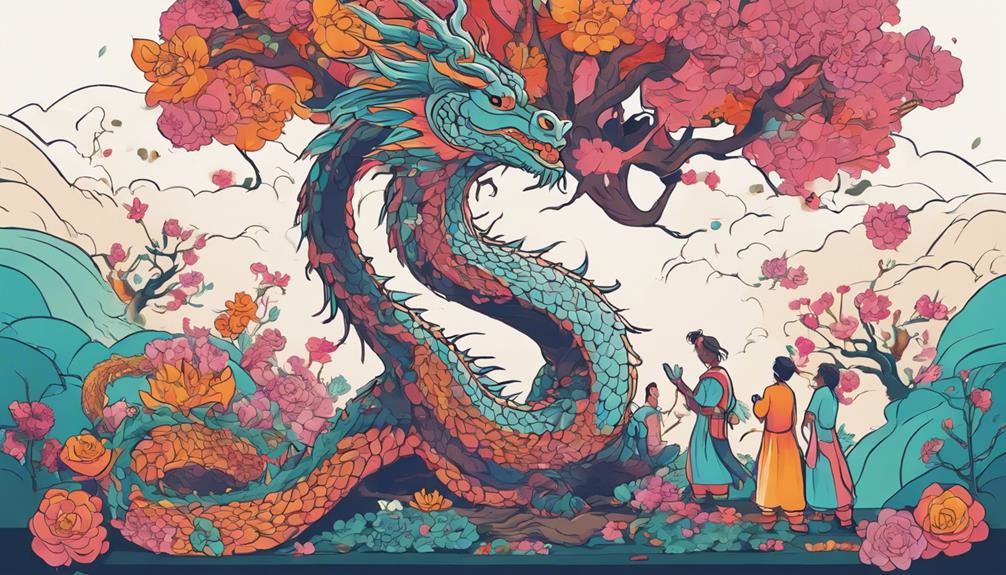
Portraying profound symbolism, mythical creatures serve as allegorical representations of various virtues and concepts across diverse cultural narratives. These creatures, deeply embedded in folklore and mythology, carry symbolic meanings that resonate with human experiences and values:
- Dragons: Symbolize power, strength, and wisdom in various cultures, often representing formidable challenges that must be overcome through courage and cunning.
- Phoenix: Represents resurrection and immortality in mythological stories, symbolizing the cycles of life, death, and rebirth.
- Unicorns: Often seen as symbols of purity, beauty, and grace in folklore and legends, embodying ideals of innocence and enchantment.
- Kraken: A sea monster in Scandinavian mythology, embodies the mysteries and dangers of the deep ocean, symbolizing the unknown and uncontrollable forces of nature.
- Centaurs: Half-human and half-horse beings, symbolize the duality of nature and the struggle between civilization and primal instincts, reflecting the complexities of human nature and societal evolution.
Rituals Based on Storytelling
Rituals based on storytelling, such as those found in ceremonies and mythical dance performances, play a crucial role in cultural preservation and transmission. These rituals often serve as a medium for passing down historical narratives and values to younger generations, fostering a sense of cultural identity and community through shared stories and traditions. By incorporating legends into celebrations and ceremonies, societies maintain a connection to their past while shaping their present and future.
Storytelling in Ceremonies
Story-centered ceremonies that incorporate storytelling serve as a vital mechanism for the intergenerational transmission of cultural heritage and values. These rituals based on storytelling play a crucial role in passing down traditions, reinforcing cultural identity, and instilling moral lessons within a community. Through the retelling of myths, legends, and historical events, participants in these ceremonies strengthen their connection to their heritage and ancestors. The sense of unity and belonging fostered by story-centered ceremonies enhances the cultural cohesion of the community, creating a shared narrative that binds individuals together. By integrating storytelling into rituals, societies can ensure the preservation of their heritage while imparting essential ethical and social norms to future generations.
- Facilitates intergenerational transmission of cultural heritage
- Reinforces cultural identity and unity
- Instills moral lessons and ethical values
- Strengthens the connection to heritage and ancestors
- Promotes community cohesion through shared narratives
Mythical Dance Performances
Mythical dance performances, as intricate expressions of cultural narratives through movement and symbolism, play a pivotal role in connecting communities to their shared heritage and fostering a collective sense of identity and belonging. These traditional rituals depict stories and legends through choreographed movements, offering a visual representation of cultural beliefs, values, and historical events. By incorporating storytelling into dance, these performances serve as a powerful form of cultural expression and preservation, ensuring the transmission of traditions across generations. Through the use of intricate choreography and music, mythical dance performances bring myths and legends to life, captivating audiences with their compelling visual storytelling. Overall, these rituals based on storytelling serve as a vital link to the past, enriching the cultural tapestry and strengthening the bonds within communities.
Legends in Celebrations
Embedded within the fabric of cultural celebrations are the enduring legends that serve as vessels of storytelling, carrying the rich narratives and values of a community across generations. Rituals based on storytelling help communities connect with their history, traditions, and shared identity. Celebratory events like festivals, ceremonies, and holidays frequently involve legends that hold significance for the culture. Storytelling in rituals serves as a way to reinforce cultural norms, beliefs, and practices within a community. Through the retelling of legends in celebrations, people maintain a sense of belonging and unity with their cultural heritage.
- Legends pass down stories and values
- Rituals connect communities with shared history
- Celebrations involve legends significant to culture
- Storytelling reinforces cultural norms
- Retelling legends maintains cultural heritage
Evolution of Cultural Narratives
In the study of cultural evolution, the transformation of narratives stands as a pivotal indicator of societal shifts and values. Cultural narratives, influenced by the power of storytelling, serve as a fundamental component in shaping a society's collective identity. These narratives evolve over time, mirroring the changes in societal values, beliefs, and traditions. Through stories and legends, historical events and collective experiences are preserved, contributing to the cultural memory of a community.
As societies progress and adapt to technological advancements and globalization, cultural narratives also undergo significant changes. The evolution of these narratives is a dynamic process, reflecting the shifting social dynamics and norms within a society. Stories and legends play a crucial role in not only passing down knowledge, morals, and customs to future generations but also in shaping cultural norms, rituals, and belief systems. By examining the evolution of cultural narratives, one can gain insights into the values and ideologies that underpin a society's cultural fabric.
Influence on Art and Literature
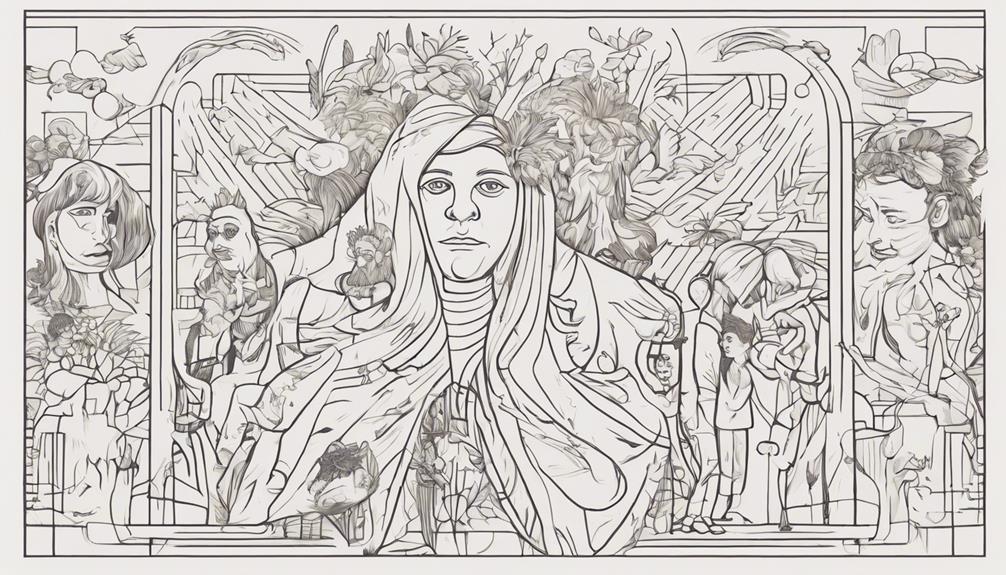
Stories and legends have long been a wellspring of artistic inspiration, with artists across the ages drawing upon mythological themes and characters to create culturally significant works. This influence is particularly evident in literature, where classic pieces often find their roots in ancient myths and legends, showcasing the enduring impact of these tales on creative expression. By exploring and interpreting mythological stories, writers and artists tap into a rich source of material that reflects the deep interconnectedness between culture, creativity, and storytelling traditions.
Artistic Inspiration From Stories
Artistic creators across various disciplines draw profound inspiration from the rich tapestry of myths, folktales, and legendary narratives that have transcended time and culture.
- Artists often use myths and legends as a foundation for their creations, infusing their work with cultural significance and depth.
- The reinterpretation of traditional stories allows for the exploration of contemporary themes and ideas, bridging the past and present.
- Writers and filmmakers adapt ancient tales to address current societal issues, creating a dialogue between the old and the new.
- The symbolism and characters found in stories offer artists a diverse range of creative avenues to explore and express complex emotions.
- By drawing from cultural narratives, artists and authors contribute to the preservation and evolution of cultural heritage through their works.
Literary Themes in Culture
Cultural narratives embedded within literature play a pivotal role in shaping the artistic landscape and creative expressions across various mediums. Literary themes in culture form an integral part of art and literature, providing a foundation for inspiration and interpretation. These themes, often derived from cultural stories and legends, serve as a lens through which artists and writers depict societal values, beliefs, and traditions. By drawing upon these themes, creators weave narratives that capture the essence of a culture and convey deeper meanings, emotions, and universal human experiences. Through the incorporation of literary themes from culture, art and literature not only reflect the richness and diversity of different societies but also contribute to the preservation and celebration of various traditions.
Impact on Social Norms
The influence of stories and legends on social norms is profound, as they serve as foundational pillars in shaping societal behavior and values. These narratives not only entertain but also impart lessons and shape cultural norms that guide human conduct within a community.
- Moral Guidelines: Stories often convey moral lessons, teaching individuals about right and wrong behavior.
- Cultural Values: Legends reinforce cultural values, influencing how individuals perceive and interact with the world around them.
- Identity Formation: Myths contribute to the formation of collective identity by instilling a sense of shared history and heritage.
- Taboos and Expectations: Through storytelling, communities establish taboos and societal expectations that regulate behavior.
- Social Structures: Legends play a role in maintaining social structures by upholding traditions, rituals, and norms that govern interactions within a society.
In essence, stories and legends are powerful tools that shape social norms, influencing behavior, values, and the overall fabric of a community's culture.
Preservation of Ancestral Wisdom
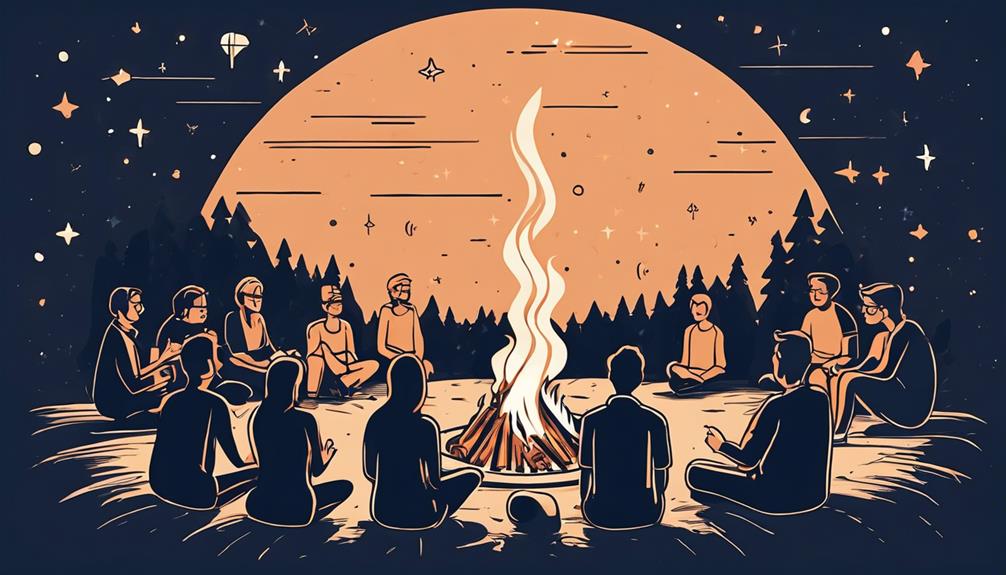
Preservation of ancestral wisdom through storytelling is crucial for maintaining cultural heritage and passing down traditions. These stories influence the values and beliefs of a community, shaping its identity and providing a connection to the past. By upholding ancestral wisdom, societies ensure the continuation of valuable teachings and insights for future generations.
Ancestor Stories Influence
Within the tapestry of human history, the enduring influence of ancestor stories on societal development and individual identity is unmistakable. These stories serve as a crucial link to the past, carrying wisdom, traditions, and values across generations. Through ancestor stories, moral lessons, cultural norms, and historical accounts are transmitted, shaping the heritage and identity of communities. Ancestor stories provide a sense of continuity and belonging, fostering a connection to one's roots. By engaging with these narratives, individuals gain insights into their cultural heritage, which in turn influences their self-perception and understanding of their place within society.
- Ancestor stories pass down wisdom, traditions, and values from previous generations.
- These stories often contain moral lessons, cultural norms, and historical accounts.
- They play a vital role in preserving the heritage and identity of a community or society.
- Ancestor stories provide a connection to the past, fostering a sense of continuity and belonging.
- By sharing these stories, individuals learn about their roots, shaping their understanding of self and culture.
Cultural Heritage Preservation
Safeguarding ancestral wisdom, traditions, and values for the benefit of future generations is at the core of cultural heritage preservation efforts worldwide. Indigenous communities prioritize the preservation of their ethnic cultures through the oral transmission of stories,传统故事, and传说. These narratives serve as a bridge between the past and present, ensuring the传承 of historical knowledge and cultural identity. Museums, archives, and cultural institutions play a vital role in保存民族文化 by documenting and protecting tangible and intangible heritage. By actively engaging in文化传承, these entities contribute to the保护 and传承 of diverse human heritage, enriching the global tapestry of文化遗产. Cultural heritage preservation is essential for maintaining the uniqueness and richness of cultures across different regions and communities.
Passing Down Traditions
The perpetuation of ancestral wisdom through the oral transmission of stories and legends is integral to the preservation and continuity of cultural heritage. This method of passing down traditions ensures that valuable insights, beliefs, and practices are not lost but instead are carried forward through generations. Through storytelling, individuals connect with their roots and gain a deeper understanding of their history. Moreover, cultural norms, rituals, and customs are reinforced, providing a sense of identity and belonging within a community. By immortalizing the experiences, achievements, and lessons of ancestors through narratives, storytelling becomes a powerful tool in maintaining the richness of cultural heritage for future generations.
- Oral transmission maintains ancestral wisdom.
- Stories connect individuals to their history.
- Cultural practices are reinforced through storytelling.
- Ancestors' lessons are shared and immortalized.
- Passing down traditions ensures continuity of cultural heritage.
Adaptation of Stories Over Time

As stories and legends traverse through time, their adaptation to evolving cultural landscapes serves as a testament to the dynamic interplay between tradition and innovation. Stories undergo a process of adaptation to suit the changing cultural contexts, beliefs, and values of society. This evolutionary phenomenon allows stories to maintain relevance and resonate with new generations, ensuring their longevity and continued impact on culture. Cultural influences play a significant role in shaping the evolution of stories, infusing them with new layers of meaning and interpretation.
The adaptation of stories not only preserves cultural heritage but also reflects societal shifts and advancements. By adapting stories, communities can keep their traditions alive while also allowing for growth and transformation in line with contemporary values. This process of adaptation ensures that stories remain dynamic and continue to shape culture for years to come, demonstrating the resilience and adaptability of storytelling in the face of changing times.
Cultural Identity Through Myths
Cultural myths play a pivotal role in shaping and preserving the collective identity of communities by encapsulating historical narratives, values, and traditions handed down across generations. These myths have been integral to shaping culture since the dawn, providing a framework through which communities understand themselves and the world around them. Here are key points highlighting the significance of cultural identity through myths:
- Reflection of Beliefs and Customs: Cultural myths often mirror a community's beliefs, customs, and rituals, fostering a sense of shared heritage and belonging.
- Conveyance of Moral Lessons: Through storytelling, myths convey moral lessons, societal norms, and collective experiences that reinforce the group's identity.
- Explanations for Phenomena: Myths help communities make sense of the world by offering explanations for origins, natural phenomena, and significant events.
- Cultural Cohesion: The retelling of myths and legends strengthens cultural cohesion, fosters intergenerational bonds, and promotes a sense of cultural continuity.
- Historical Continuity: Myths serve as a link to the past, preserving traditions and ensuring continuity across generations.
Resonance of Legendary Heroes
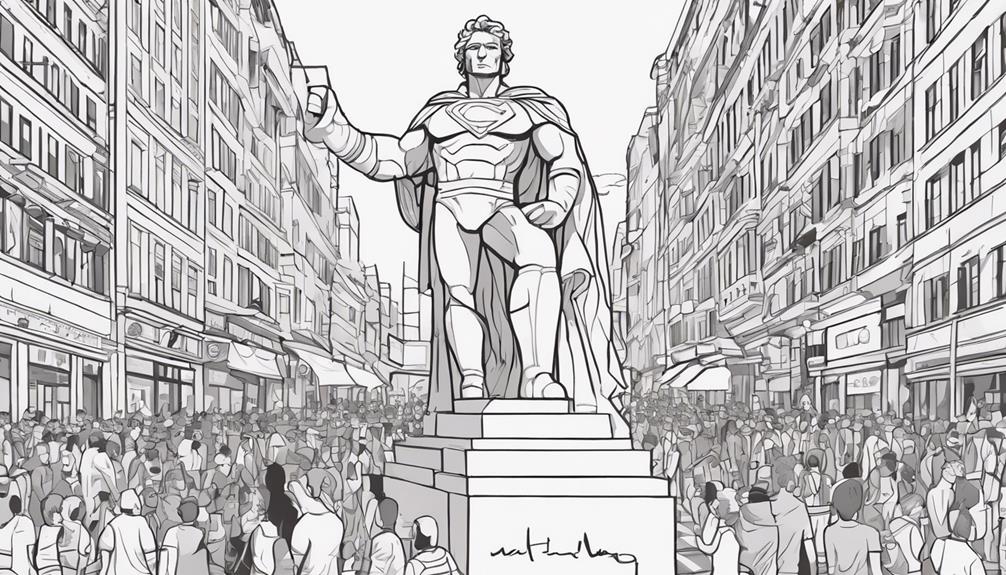
Within the annals of cultural narratives, legendary heroes stand as enduring symbols of societal virtues and aspirations. These figures, such as King Arthur and Hercules, play a crucial role in shaping cultural identity by embodying the values and ideals that a society holds dear. Through their tales of bravery, justice, and heroism, legendary heroes provide a blueprint for individuals to understand and construct their own identity within the framework of their culture.
To further emphasize the impact of legendary heroes on cultural identity, the table below illustrates key aspects of their resonance:
| Aspects | Impact on Identity |
|---|---|
| Moral Lessons | Teach values and principles that shape personal beliefs |
| Role Models | Inspire individuals to emulate qualities of heroism |
| Cultural Pride | Instill a sense of belonging and shared heritage |
| Resilience | Encourage perseverance in the face of challenges |
| Collective Identity | Unite communities through shared admiration |
Through these various facets, legendary heroes not only entertain but also contribute significantly to the formation and reinforcement of cultural identity.
Interplay of Fact and Fiction
The intricate weaving of historical truths and imaginative constructs in stories and legends intricately reveals the interplay of fact and fiction within cultural narratives. This interplay is an integral part of human storytelling, shaping the way societies perceive themselves and the world around them. Here are some key points to consider:
- Blending of Fact and Fiction: Stories and legends often intertwine real events with fictional elements to create compelling narratives that resonate with audiences.
- Transmission of Cultural Norms: Through the fusion of fact and fiction, cultures can pass down historical events and societal values from one generation to the next.
- Preservation of Traditions: By incorporating imaginative elements into stories, cultures can keep important traditions alive and relevant in a rapidly changing world.
- Reflection of Society: The interplay of fact and fiction in legends acts as a mirror to society, reflecting its ideals, fears, and shared experiences.
- Exploration of Complex Themes: Fact and fiction in stories provide a platform for cultures to delve into intricate themes, convey moral lessons, and provoke critical thinking among audiences.
Sacred Stories and Beliefs
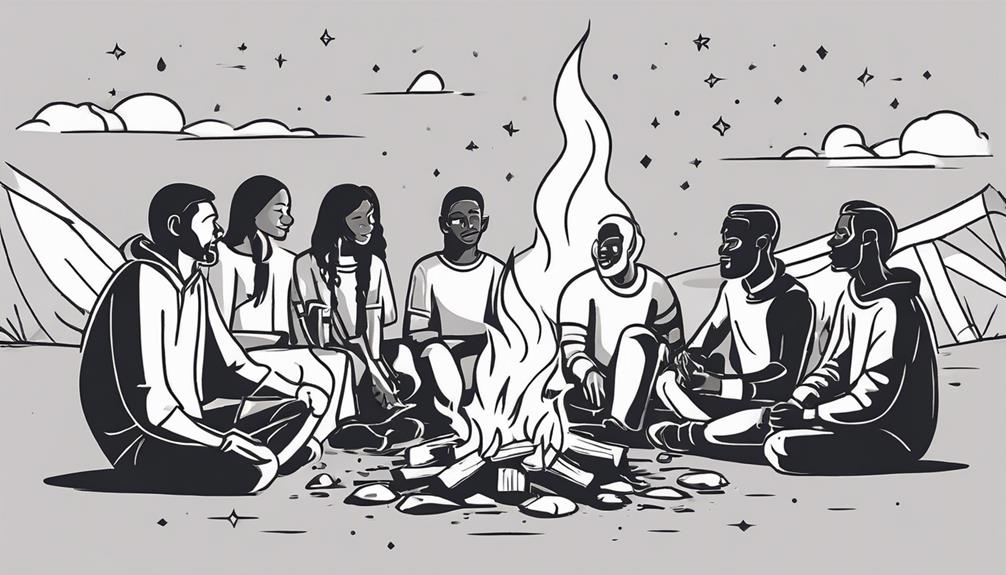
Sacred stories and beliefs play a fundamental role in shaping the moral fabric and societal structure of civilizations. These narratives, often rooted in religious or spiritual contexts, hold significant influence over human behavior, values, and worldviews. Through sacred stories, individuals gain insights into the origins of humanity, the purpose of existence, and the nature of the universe. By providing explanations for complex phenomena and offering moral guidance, these stories help establish a framework for ethical conduct and decision-making.
Human societies have long relied on sacred stories to instill cultural values, norms, and traditions. Passed down through generations, these beliefs serve as a cornerstone of cultural heritage, reinforcing a sense of identity and belonging within communities. Rituals, ceremonies, and traditions often derive their significance from these sacred narratives, connecting individuals to their shared past and collective identity. As a result, sacred stories and beliefs contribute to the cohesion and stability of societies, shaping both individual behaviors and societal structures.
Global Significance of Local Tales
Local tales from diverse cultures around the world play a crucial role in fostering global understanding and appreciation for the richness of storytelling traditions. These stories have been integral to human culture since ancient times, shaping beliefs, values, and societal structures. The global significance of local tales can be understood through various key points:
- Local tales hold significant cultural value and are often passed down through generations to preserve heritage.
- They reflect the unique identity and traditions of a community, contributing to a sense of belonging and continuity.
- Interest in local tales has grown globally due to their ability to provide insights into diverse cultures and promote cross-cultural understanding.
- These tales serve as a means of transmitting moral values, societal norms, and historical events within a specific cultural context.
- Sharing local tales on a global platform enables different cultures to appreciate the richness and diversity of storytelling traditions worldwide.
Frequently Asked Questions
How Do Stories Shape Our Culture?
Stories are integral in shaping culture through the transmission of cultural narratives. They serve as vehicles for passing on values, traditions, and beliefs, fostering a shared understanding of identity within communities. By explaining the unexplainable and providing moral lessons, stories influence societal norms and behaviors. Through storytelling, culture is preserved, celebrated, and constantly evolving, reflecting the dynamic nature of human experiences and beliefs.
How Do Legends Promote Culture?
Legends promote culture by preserving and transmitting cultural traditions across generations. Through captivating narratives, they convey historical events, values, and societal norms, instilling a sense of identity and belonging within communities. These stories serve as educational tools, imparting moral lessons and reinforcing shared beliefs and customs. By inspiring creativity and imagination, legends shape artistic expressions and cultural innovations, fostering social cohesion, unity, and the preservation of cultural heritage.
How Do Myths and Legends Shape Cultural Identity?
Myths and legends play a pivotal role in shaping cultural identity by weaving narratives that encapsulate cultural heritage. Through these stories, individuals derive a sense of belonging and connection to their roots, fostering a deep understanding of their cultural lineage. By embodying cultural values, beliefs, and traditions, myths and legends serve as a mirror reflecting the essence of a community's collective identity, thereby reinforcing a shared sense of heritage and continuity.
Do Legends Effect on the Culture?
Legends wield a significant cultural influence, shaping societal norms, values, and identity. Through storytelling, they transmit moral lessons, ethics, and wisdom across generations, fostering a cohesive cultural fabric. These narratives contribute to the collective consciousness of a community, influencing beliefs and worldviews. The impact of legends on culture is profound, guiding artistic expressions, rituals, and traditions, thus playing a pivotal role in shaping the ethos of a society.
Conclusion
In conclusion, stories and legends have a profound impact on shaping culture by preserving traditions, transmitting values, and influencing societal norms. Despite their fictional nature, these narratives hold significant power in guiding behaviors, beliefs, and decision-making processes within communities. Through the interplay of fact and fiction, cultural stories continue to resonate across generations, perpetuating a rich tapestry of heritage. The irony lies in the fact that these fictional tales often hold more influence over individuals' lives than factual information.
